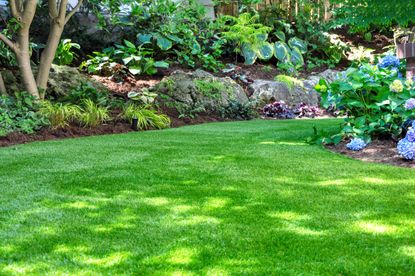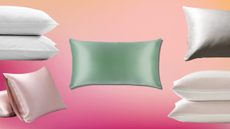How to get rid of weeds from a lawn – the best tricks to try, according to gardening experts
If your lawn is overcome with weeds, here's how the experts suggest tackling them


You might not think it but fall is an important time for your lawn. It may not be getting the attention it usually does in spring and summer, but keeping it looking good through this period can be equally as tricky. Due to the cooler and generally wetter weather conditions, weeds become a common hindrance to a perfect-looking lawn.
Weeds aren't permanent, but they are annoying. We love nothing more than to have a pristine lawn, and luckily there are many ways to do this. We consulted some of the best lawn experts to find out their secrets to a weed-free lawn and how we can achieve it too.
A good-looking lawn shouldn't be seasonal or reserved for those lucky enough to have a professional gardener. Check out these tips and discover you can have a perfect lawn all year round.
Things that encourage weeds
Weeds occur in all backyards, however, there are certain things that encourage their growth and regrowth. Being aware of these factors may help you to understand your outdoor space better, and avoid promoting weeds.
'Poor lawn health is a fast way to encourage weeds,' says expert gardener and founder of The Plant Bible, Zahid Adnan. To negate this encouragement ensure you're up to date with your fall lawn maintenance.
As part of your fall lawn routine you should be aerating the soil, it is the 'unsung hero of lawn care,' according to the CEO of GreenPal, Bryan Clayton. It will also help to discourage weeds from growing. 'Compacted soil can create opportunities for weeds to take root,' explains Zahid, 'aerate your lawn to improve soil structure and prevent this.'
Lastly, it could be done to grass clippings. Although cutting your lawn short can help to remove and discourage weeds, leaving the cut grass on the lawn can have an adverse effect. 'Grass clippings should be removed or mulched finely. Large clumps of clippings can provide a haven for weed growth,' Zahid explains.
In gardening, prevention is half the battle, fix these issues before attempting to remove weeds. You will find it halves your workload.
How to get rid of weeds from a lawn
1. Pull them out by the roots
'Pulling out weeds by their roots is the most effective way to eliminate them entirely,' says Jeremy Yamaguchi, CEO of Lawn Love. Not only does it remove that weed, it also 'prevents their ability to germinate and spread,' explains Jeremy. This means you will have to spend less time on the task going forward.
When trying to tackle weeds pulling them out by hand it a great first step to take, however, if you have a large backyard this may feel like an impossible task. In which case you should double it up with other solutions. If you have a small backyard or alternatives to lawn you may not need to bother with the other steps.
2. Herbicides
Herbicides get bad press. Some of you may believe that they will kill your lawn, but this I certainly not the case for all. 'Selective herbicides formulated for lawns can target weeds while sparing your grass,' says Zahid, 'just make sure you follow the instructions carefully and apply when the weeds are actively growing.'
Glycosulphate is the strongest weed killer out there, but it will almost certainly kill your grass as it kills the weeds. Our professional gardeners advise reserving this solution for driveways, patios, and grass alternatives. Instead opt for one specifically for weeds in your lawn.
3. DIY weed killers
If you are constantly buying herbicides for a large space it can get expensive, and whilst you can remove them by hand this will eat into your time and may still require a chemical solution. Thankfully there is a DIY weed killer that is both effective and affordable, and you probably have all the ingredients already.
'One of the most effective DIY weed-killers is a solution that contains apple cider vinegar, dish soap, and salt,' explains Jeremy. All of these items can be purchased inexpensively at your local grocery store, you probably already have them. The amounts that I use to make this solution are 1 gallon of apple cider vinegar, 1 ounce of dish soap, and 1 tablespoon of salt,' he says. This DIY solution words to attack and dehydrate the weeds, 'they don't stand a chance' according to Jeremy.
This is a great trick for all types of gardens to keep the lawn looking weed-free and doubles as a great preparation for spring. However, this concoction is potent, avoid getting it on any other plants as they will not be able to survive it either.
When's the best time to weed a lawn?
Thankfully there isn't really a right or wrong time to get rid of weeds, however, our gardening expert Zhaid did have some guidelines.
'Fall is a great time for lawn renovation,' he says, 'make use of the cooler weather to aerate and overseed a lawn to promote healthy grass growth and crowd out weeds.'
Herbicides can then be proactively applied through spring and summer. 'Use pre-emergent herbicides in early spring to stop the weeds from germinating,' he explains, 'and post-emergent herbicides in summer when weeds are actively growing.'
Remember, achieving a weed-free lawn is a process that requires regular maintenance and proper care. 'Integrated weed management, which combines different techniques, is often the most effective strategy for long-term weed control in your lawn,' says Zahid. Incorporate these techniques into your gardening routine to keep the weeds under control and work towards eradication entirely.
Top buys for a weed free lawn

Size: one size
Price: $5.99

Size: 42 inch
Price: $49.98

Size: 1.33 gallons
Price: $23.49
Be The First To Know
The Livingetc newsletter is your shortcut to the now and the next in home design. Subscribe today to receive a stunning free 200-page book of the best homes from around the world.

Amy recently completed an MA in Magazine Journalism at City, University of London, with experience writing for Women’s lifestyle publications across arts, culture, and beauty. She has a particular love for the minimalist aesthetic mixed with mid-century furniture, especially combining unique vintage finds with more modern pieces. Her previous work in luxury jewellery has given her a keen eye for beautiful things and clever design, that plays into her love of interiors. As a result, Amy will often be heard justifying homeware purchases as 'an investment', wise words to live by.
-
 What are the Most Comfortable Pillowcases? From Temperature Regulating to the Best for Your Skin
What are the Most Comfortable Pillowcases? From Temperature Regulating to the Best for Your SkinWhen you're looking for comfort in your pillowcases, material matters. These are the best you can buy
By Faaizah Shah Published
-
 5 Simple, but Genius Bathroom Layout Tricks That Will Make Your Space Work so Much Harder
5 Simple, but Genius Bathroom Layout Tricks That Will Make Your Space Work so Much HarderSmall switches to how you lay out your bathroom that help make the most of a small space
By Luke Arthur Wells Published

